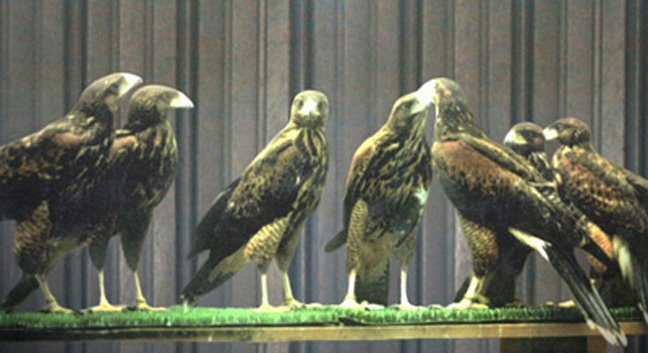
Well, sometimes life literally thrusts opportunities or birds in your face and you have to choose what's best for both. Scirroco has a new best friend as of yesterday.
New development is often created at the expense of wildlife. Cranbrook is experiencing a growth spurt as a result of increased human population and the greater disposable income enjoyed by a good economy of B.C. and Alberta. The Columbia Valley (Cranbrook is at the southern end) has become a recreational playground for Albertans for many years now and is currently embracing the recreational economic benefits of golf. There is a new course being created on the outskirts of the city along the St. Mary's river. It is being claimed by the course developers that 2 RT hawklets were found on the ground Friday, June 27, 2008 as a result of falling out of their nest tree.
The birds were retrieved by a local mammal rehabber and moved to their facility. As some of you are aware I had my newly constructed mews inspected (a regulation of falconry) by a local biologist with our Fish and Wildlife office. During that visit the situation with these hawklets was relaid to me and the biologist asked me if I would mind visiting the facility and consider accepting one of the hawklets as the second bird of my capture permit of 2008. When I visited the hawklets they were a little older than was suggested and one had a scabbed injury on it's left side of the face, behind the mouth/gape and below the ear. Both birds were alert and showed a expected level of fear which is good. Though it was not my 1st choice but one made out of consideration for the big picture welfare of the younger, slightly injured hawklet I chose to accept the bird and raise it as a falconry/education bird and possible mate for Scirroco (although this is the last of a long list of considerations and neither birds gender has been confirmed. They may both be males and hopefully both are not females). So the Redtail population in Scirroco's territory has doubled. The fun and science has expanded.
The new (yet un-named) hawklet is possibly 4-5 days older than Scirroco, the size comparisons are very similar with the toes possibly being a little thicker and the weight slightly greater. The new bird is much more cautious and defensive but a few days of exposure to me will lessen that greatly. The bird won't eat on its own at this time. More likely a result of fear than anything else and has a softer version in it's repertoire of vocalizations, something Scirroco has yet to reveal.




 The second mew has been framed in and will soon be complete. It will be modified to house Chapal the tiercel Peregrine.
The second mew has been framed in and will soon be complete. It will be modified to house Chapal the tiercel Peregrine.














